Pump prices are continuing to increase, with petrol up by 6 pence per litre (ppl) since the start of the year and diesel recording three consecutive months of rises.
New data from RAC Fuel Watch shows that petrol increased by almost 2ppl in March, from 144.62p to 146.48p.
Diesel rose by more than a penny from 154.68p to 155.99p.
The increase in forecourt prices has been driven by a 5% rise in the cost of a barrel of oil (from $83.55 to $87.48), while a surge in demand for petrol in the US has caused the wholesale price of unleaded to rise to match that of diesel.
It meant that by the end of March, a litre of unleaded cost 113.3p on the wholesale market, only a penny or so less than diesel at 114.69p.
If this remains the case, the gap between the two fuels at the pumps should close from its current 7p in the next few weeks.
Analysis by the RAC also suggests that the increase in the cost of wholesale petrol has squeezed the average retailer margin which has now reduced to 8p a litre, in contrast to 10.5p at the beginning of the month.
The average margin on diesel is much higher at 11p, up by a penny over the same period.
RAC fuel spokesman Simon Williams said: “The rising cost of oil, combined with the pound still only being worth a meagre $1.3, has led to another month of misery at the pumps with the price of petrol going up 2p a litre. Sadly, this means the average price of petrol has gone up nearly 6p so far this year.”
In terms of pump prices at the big four supermarkets which dominate UK fuel retailing, Tesco had the cheapest unleaded on March 31 at an average of 142.7p across its 511 forecourts, while Asda had the most expensive at 145p.
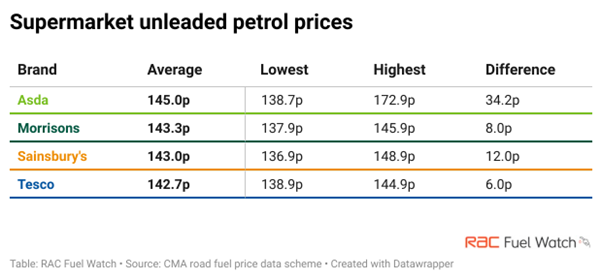
Asda also had a 34p price difference between its cheapest and most expensive petrol. The grocer charged 138.7p at its Guildford forecourt and 172.9p at junction 29A of the M1 near Sheffield – a Shell-branded site operated by Asda.
Comparatively, Tesco had the smallest difference between its lowest and highest prices at just 6p (138.9p v 144.9p).
At the end of March Sainsbury’s sold the cheapest unleaded at 136.9p at two sites – one in Wolverhampton and one at Dungannon in Northern Ireland.
Tesco, however, was charging its lowest price – 138.9p – at 30 separate forecourts. Asda, on the other hand, was only charging its lowest petrol price of 138.7p at one of its 658 forecourts.
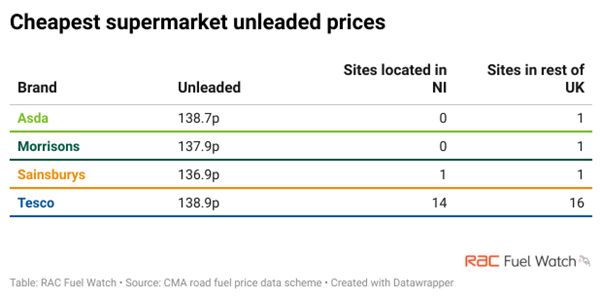
Sainsbury’s and Tesco were tied for the lowest average diesel price across their portfolios at 151.7p and 151.8p. Asda’s gap between its cheapest and most expensive diesel was 35.2p (147.7p at Guildford, Torquay and two in Northern Ireland v 182.9p at the Shell-branded site it runs near junction 29 of the M1).
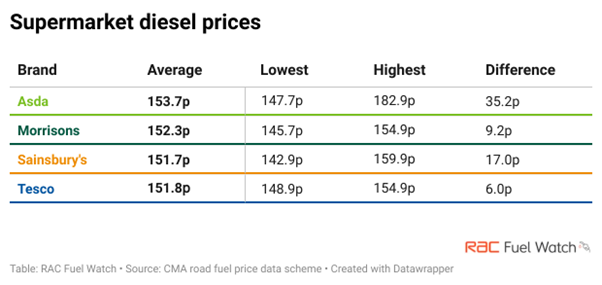
Tesco had the smallest gap of just 6p between diesel at its forecourts (148.9p v 154.9p), while Morrisons was also under 10p (145.7p v 154.9p) Sainsbury’s had the cheapest diesel at 142.9p, but this was only available at Andersonstown, near Belfast, in Northern Ireland.
Tesco’s lowest price of 148.9p was, however, on offer at 45 of its forecourts.
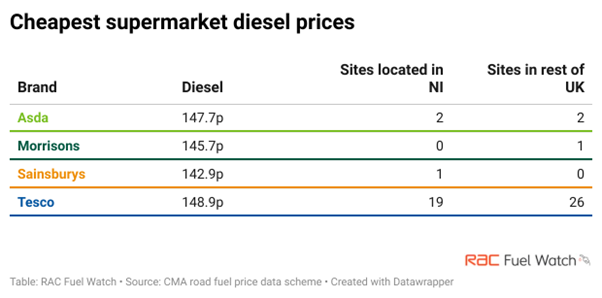
BP and Shell-operated forecourts also have very large differences between their cheapest and highest fuel prices. For unleaded BP has a gap of 27p (142.9p v 169.9p) and Shell 26p (143.9p v 169.9p) across their 287 and 536 forecourts. For diesel, it is 30p for BP (149.9p v 179.9p) and 26p for Shell (153.9p v 179.9p).
Williams says that the RAC’s analysis of the fuel price data being compiled by the Competition and Markets Authority (CMA) shows that Asda is no longer the cheapest retailer as, at the end of March, Tesco had the lowest average petrol price across its 511 forecourts. It was also joint cheapest for diesel with Sainsbury’s.
He added: “The data from the competition watchdog also highlights the wildly different prices BP and Shell charge at the forecourts they own and run.
“Worryingly, there is sometimes as much as 30p between their high and low prices.
“We badly need to see an end to this practice as this postcode lottery is extremely unfair on drivers.”
He concluded: “On a more positive note, it’s good to see the average retailer margin on petrol come down from 10.5p a litre at the start of March to under 8p.
“While the cause is most likely to be the increase in the wholesale price of petrol, it could also be due to the CMA again raising concerns about higher retailer margins very publicly just last week.”



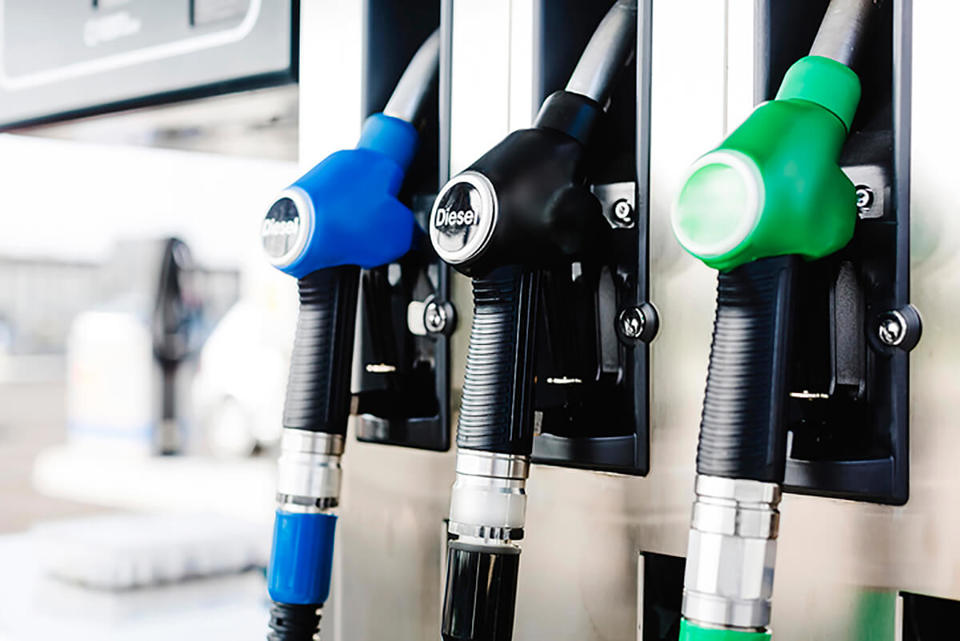

















Login to comment
Comments
No comments have been made yet.